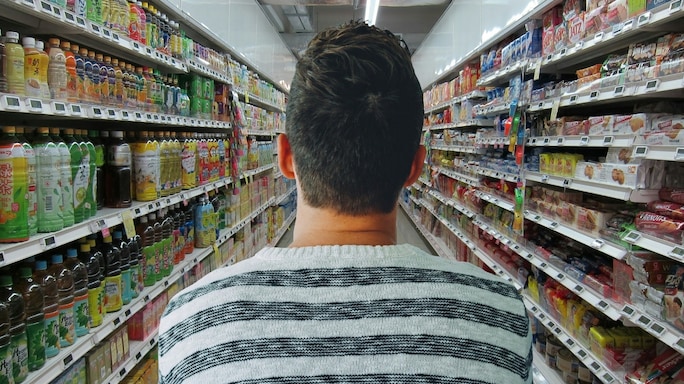- HOME
- /
- Culturescape
- /
- Book Extract
- /
Food For Thought: How what we choose to eat is affecting our environment
Food writer and researcher Charmaine O’Brien explores the not-so-hidden cost of choosing packaged 'convenience' food
 Mohamed Hassan; Pixabay
Mohamed Hassan; Pixabay
31 December 2019. R and I are driving back to Delhi from Patiala, Punjab. The journey takes several hours longer than expected, and the early winter evening has started to settle in by the time we reach the outskirts of Delhi. As we head towards the city, the landscape evolves from sprawling agro-industrial into urban density, twinkling with the light of homes, roadside vendors, and small stores. Suddenly, I notice a distinct change in the atmosphere around us. I look out to my left and there seems to be a void—a vast black empty space. Then, I notice a patch of glowing, undulating, deep orange seemingly floating above this abyss. Someone of a more religious orientation might have taken this as a vision, but it was a fire. I asked R, ‘What are we driving past?’ He looks to my side and says, ‘It’s a rubbish tip. The Bhalswa landfill.’
Every major city in India has similar dumping sites, typically located on its outskirts: Deonar in Mumbai, Dhapa landfill in Kolkata, Perungudi landfill in Chennai—‘as high as a two-storey building’. Bengaluru differs in that it dumps its waste around villages twenty kilometres outside the city—out of sight, out of mind.
It is the world’s wealthiest people who generate the most garbage: Americans send 150 times more waste into tips than the average Indian. It is completely understandable that Indians who can afford it would want to also enjoy the seeming convenience and comfort afforded by a consumption-focused lifestyle, but the sheer number of people in India amplifies the magnitude of waste this type of living generates. India’s plastic consumption has grown twenty times since liberalization, and more than half of all plastic waste is packaging waste—56 per cent compared to 40 per cent in Europe. Not all of this comes from food packaging but given the vastly increased range and availability of convenience foods in India, it is making a significant contribution to expanding India’s rubbish tips.
Changing eating patterns are moving India from a resource-conservative country to a resource-consumptive society, in the process wrapping food up into more and more packaging when there was previously very little of it: yoghurt is a good example. Go into any metropolitan food store in a prosperous neighbourhood, and there you will see it: rows and rows of yoghurt, most of it sold in plastic containers with foil and/or plastic lids and increasingly in single-serve tubs. Here is a product that most Indians eat every day that has gone from being zero waste, to being available in a ready-to-eat form, making it a very ‘convenient’ food.
What makes food convenient? Processing it into ready-to-eat meals, snacks, or meal components that cut down culinary labour is a key aspect. Food packaging facilitates convenience, novelty, differentiation, and food hygiene and safety; it can also reduce the cost of food because it allows for centralized mass production. But where does all the packing end up? A lot of it is swelling India’s rubbish dumps. Any packaging offering the solace of being labelled ‘biodegradable’ might technically be so, but the process of biodegradation cannot occur in the compressed conditions of municipal rubbish dumps as there is no oxygen in there that is needed to facilitate the process. Biodegradable packaging needs to be sorted out from other household waste going to the tip for it to be treated in a way that would allow it to degrade biologically.
The kitchen at the Shree Jagannath Temple in Puri is said to be the biggest in the world. Every day, hundreds of Brahmin cooks work to prepare food for the temple’s three presiding deities, and the many thousands who come here. As a non-Hindu, I am barred from entering the temple or eating in its dining hall; however, I was able to avail of a packing service that allowed me to enjoy a meal of the consecrated comestibles in my hotel room. The food came packed in clay pots covered with banana leaves and tied down with strips of the same; the basket it came in was also woven from this natural, and locally abundant, material, a long-standing system of low-waste food packaging. India holds vast knowledge about conserving resources, including food, the type of practices recognized by the contemporary environment movement as those the world needs to look towards to make our existence more sustainable. India’s domestic cooks have typically been very careful with food, painstakingly using up rice-and-grain cooking water, fruit and vegetable peels, leaves, stalks and seeds, and leftover cooked cereals, to produce other dishes, creating little, if any, waste.
While the food habits of an increasing number of Indians are changing towards the type of consumer lifestyle that generates substantial waste and sends much of it off to fester in dumps, it seems, fortunately, that not all of it ends up there. Households, itinerant waste merchants and garbage collectors in India jointly recover 1.2–2.4 million tonnes of newspapers, 2.4–4.3 million tonnes of cardboard and mixed paper, 6.5–8.5 million tonnes of plastic, more than 1.3 million tonnes of glass, more than 2.6 million tonnes of metal waste and 4–6.2 million tonnes of other recyclable material per year. Overall, 30–60 per cent of all paper and cardboard, 50–80 per cent of all plastic and close to 100 per cent of all glass bottles produced in India are recycled.
That India recycles so much of its waste is an admirable track record, far exceeding that of many wealthy industrialized countries. It is poor migrant workers who do much of the work of sorting rubbish for recycling in India’s cities. And if Indian consumers continue to grow their consumption of packaged foods, and other goods, will the system be able to cope? According to a 2021 report, there are already not enough people, plants, or dealers in India’s separation and recycling system to cover all the recyclable waste generated.
India faces the collective challenge of balancing consumer spending power with environmental imperatives. Weighing up the ecological as well as the social and cultural costs of ‘convenience’ food against its benefits is part of this challenge for contemporary Indians. Solving the problem of overall waste management in India will require ‘joint initiatives from an array of entities such as the government, corporates, retailers, and of course the general public’.
Acknowledging again that food packaging is only a part of the waste generated, it still seems that one of the more simple contributions that the ‘general public’ could make is to limit the amount of packaged food they purchase. But perhaps that is really romantic thinking: That would require a return to preparing meals from scratch or actually going out to a restaurant to eat a restaurant meal (less OTT time) or taking our own containers to be filled when purchasing pre-prepared food, but the convenience food genie is now well and truly out of the bottle in India, and industry and consumers will not want to put that particular djinn back inside. Let’s hope someone out there is developing edible packaging.
Excerpted from the Eating the Present, Tasting the Future: Exploring India Through Her Changing Food by Charmaine O’Brien. Published by Penguin Books, April 2023






